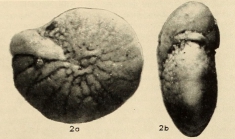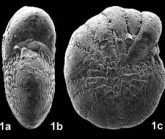
| Intro | | About | | Wiki | | Search traits | | Data explorer | | Literature | | Definitions | | Sources | | Webservices | | Statistics | | Feedback | | Editors | | Log in |
Foraminifera taxon detailsFissoelphidium Smout, 1955 †
722381 (urn:lsid:marinespecies.org:taxname:722381)
accepted
Genus
Fissoelphidium operculiferum Smout, 1955 † (type by original designation)
marine,
fossil only
neuter
Smout, A. H. (1955). Reclassification of the Rotaliidea (Foraminifera) and two new Cretaceous forms resembling Elphidium. <em>Journal of the Washington Academy of Sciences.</em> Vol. 45, No. 7 (July 1955), pp. 201-210., available online at https://www.biodiversitylibrary.org/part/70624#/summary
page(s): p. 208 [details]
Diagnosis Test lenticular, planispiral, bilaterally symmetrical, chambers numerous, septa radial, slightly curved, deeply fissured in...
Diagnosis Test lenticular, planispiral, bilaterally symmetrical, chambers numerous, septa radial, slightly curved, deeply fissured in dendritic pattern, secondarily doubled by the septal flap, periphery rounded, peripheral outline entire to gently lobulate; wall calcareous, radially fibrous, distinctly perforate, lamellar, surface of umbonal mass and early part of the last whorl with reticulate fissures on both sides, final chambers smooth; aperture equatorial, of numerous pores in a protruding crescentic apertural plate that is resorbed as the next chamber forms and leaves an arcuate slitlike intercameral foramen. U. Cretaceous (Maastrichtian); Qatar: Persian Gulf; Iraq. (Loeblich & Tappan, 1987, Foraminiferal Genera and Their Classification) [details] Diagnosis Test roughly symmetrical with a rounded periphery. Chambers arranged in a single involute planispire. Chambers have a...
Diagnosis Test roughly symmetrical with a rounded periphery. Chambers arranged in a single involute planispire. Chambers have a rounded or slightly acute periphery without keel. Aperture in the last chambers is composed by an interiomarginal slit (Smout, 1955). Alar prolongation provided by a folium at the adaxial end of chambers. Folia growth follows a general radial pattern with a slightly irregular style. Folia are wavy, infolded; bending over itself in adaxial direction. The umbilical plate separates the folium and the main chamber lumen. There are two spiral umbilical canals, one in each side of the shell, constrained between folium and the umbilical plate. The spiral umbilical canals are pseudo-tubular and roughly continuous. An interconnected network of spiral and intraseptal interlocular canals composes the canal system. The chevron-shaped canals arising from the interlocular spaces represent the enveloping canal system. Dimorphism not observed. [details] Original description The test is planispiral and bilaterally symmetrical with a single spire of equitant chambers. The shell material is...
Original description The test is planispiral and bilaterally symmetrical with a single spire of equitant chambers. The shell material is radially fibrous, perforate calcite, deposited in laminae that correspond to the chambers and build up a spiral lamina and polar plugs as in Nummulites. The septa are double and there is a lateral system of wide meandrine fissures. The septa are double in appearance in thin section, particularly in tangential sections, for the fissures penetrate slightly into them. The margin is rounded and without a marginal cord. [details]
Hayward, B.W.; Le Coze, F.; Vachard, D.; Gross, O. (2025). World Foraminifera Database. Fissoelphidium Smout, 1955 †. Accessed at: https://www.marinespecies.org/Foraminifera/aphia.php?p=taxdetails&id=722381 on 2025-05-24
Date action by
original description
Smout, A. H. (1955). Reclassification of the Rotaliidea (Foraminifera) and two new Cretaceous forms resembling Elphidium. <em>Journal of the Washington Academy of Sciences.</em> Vol. 45, No. 7 (July 1955), pp. 201-210., available online at https://www.biodiversitylibrary.org/part/70624#/summary
page(s): p. 208 [details] basis of record Loeblich, A. R.; Tappan, H. (1987). Foraminiferal Genera and their Classification. Van Nostrand Reinhold Company, New York. 970pp., available online at https://books.google.pt/books?id=n_BqCQAAQBAJ [details] Available for editors From editor or global species database
Diagnosis Test lenticular, planispiral, bilaterally symmetrical, chambers numerous, septa radial, slightly curved, deeply fissured in dendritic pattern, secondarily doubled by the septal flap, periphery rounded, peripheral outline entire to gently lobulate; wall calcareous, radially fibrous, distinctly perforate, lamellar, surface of umbonal mass and early part of the last whorl with reticulate fissures on both sides, final chambers smooth; aperture equatorial, of numerous pores in a protruding crescentic apertural plate that is resorbed as the next chamber forms and leaves an arcuate slitlike intercameral foramen. U. Cretaceous (Maastrichtian); Qatar: Persian Gulf; Iraq. (Loeblich & Tappan, 1987, Foraminiferal Genera and Their Classification) [details]Diagnosis Test roughly symmetrical with a rounded periphery. Chambers arranged in a single involute planispire. Chambers have a rounded or slightly acute periphery without keel. Aperture in the last chambers is composed by an interiomarginal slit (Smout, 1955). Alar prolongation provided by a folium at the adaxial end of chambers. Folia growth follows a general radial pattern with a slightly irregular style. Folia are wavy, infolded; bending over itself in adaxial direction. The umbilical plate separates the folium and the main chamber lumen. There are two spiral umbilical canals, one in each side of the shell, constrained between folium and the umbilical plate. The spiral umbilical canals are pseudo-tubular and roughly continuous. An interconnected network of spiral and intraseptal interlocular canals composes the canal system. The chevron-shaped canals arising from the interlocular spaces represent the enveloping canal system. Dimorphism not observed. [details] Original description The test is planispiral and bilaterally symmetrical with a single spire of equitant chambers. The shell material is radially fibrous, perforate calcite, deposited in laminae that correspond to the chambers and build up a spiral lamina and polar plugs as in Nummulites. The septa are double and there is a lateral system of wide meandrine fissures. The septa are double in appearance in thin section, particularly in tangential sections, for the fissures penetrate slightly into them. The margin is rounded and without a marginal cord. [details] From editor or global species database
Image from typetaxon
Image from typetaxon
|



